A Court of Owls: Our Neighborhood Raptors
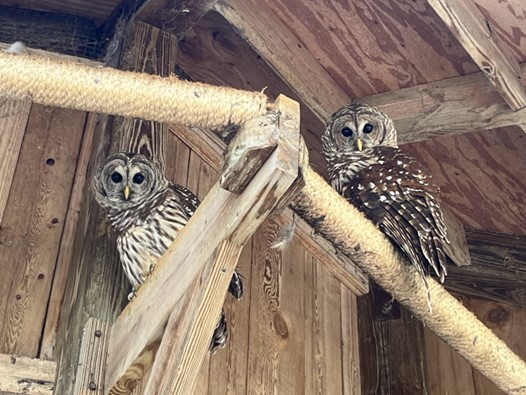
By: Alex Kogan, Library Page
October 25, 2023
Fall has arrived, where the days become shorter and the nights grow longer. When many people think of animals who dwell in the dark, chances are that owls are one group that will immediately come to mind. Florida is home to many wild fauna that appear in the daytime, especially in the spring and summer, but nighttime in the Sunshine State bears no shortage of creatures, especially ones that remain while others migrate elsewhere. And that includes these airborne masters of stealth who quietly hunt in our backyards.
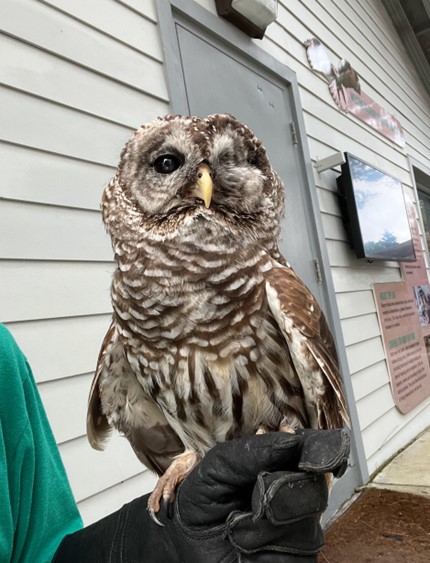
Barred owl (Strix varia):
One of the most common large-bodied owls, with a length of 17-24 inches and a 50-60 inch wingspan, dwelling in both urban areas and especially around Florida swamps and woodlands. Also known as the “hoot owl” due to their distinctive “Who cooks for you; who cooks for you all?” patterned calls, barred owls are a stout, round-headed, yellow-beaked species with plumage colored in an assortment of stripes patterned after the tall trees of which they make their nests in (brown, gray and white). Even their legs down to their feet are covered in feathers, which diminishes wind noise when in flight so as to sneak up on unsuspecting prey. They can even respond to imitations of their hoots and will move in the direction of the source to investigate out of curiosity. Unlike many other owl species, barred owls have deep dark eyes and lack ear tuft feathers. Despite the lack of tufts, they still very much have large ear cavities buried under the feathers on the sides of their skulls to pick up sounds from all around their environment. Like all owls, barred owls are birds of prey (or raptors) and as such are predators who hunt and eat other animals. While small mammals are their primary food source, they are versatile hunters and will eat just about any other small sized animals including birds, frogs, snakes, lizards, and even crabs. They are even crepuscular hunters as well as nocturnal, meaning they can be seen active even in the hours of dusk and dawn.
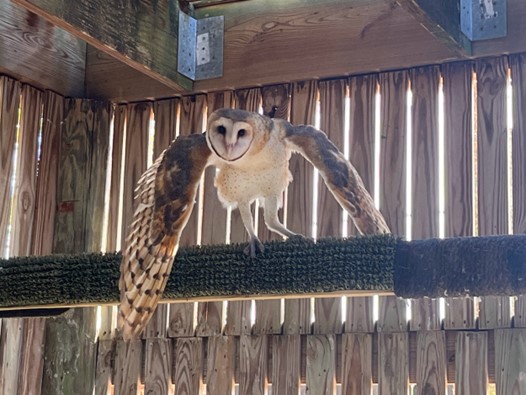
American Barn owl (Tyto furcata):
At 14-20 inches long with a 43-47 inch wingspan, and with its heart-shaped face, dark eyes, long legs, pale white frontal feathers, gold and brown streaked back feathers, and miasma of violet tinted spots, the barred owl is one of the most distinct species of owls. Barn owls are expert nocturnal hunters of small animals including rodents, birds, snakes and even bats. Besides their forward facing eyes, they are able to detect surrounding prey in total darkness thanks to their asymmetrically positioned ear cavities. Unlike most birds, but common to all owls, the rounded wings of barn owls bear comb-shaped feathers that are soft and fringed, allowing them to flap their wings without generating noise. As their name implies, barn owls are the most human associated species of owl, for they’ve adapted to living near or within man made buildings and structures (besides the more natural open fields and marshes), acting as pest control against mice and insects. They also do not hoot, but instead emit a raspy, ghostly screech. Due to their penchant for living near human habitation and harsh shrieks, the barn owl has been subjected to folklore and ghost stories by many, both in the Americas and in the case of the second species under the genus, across parts of Europe, Africa, India and southeast Asia. Because of the enormous distribution of the genus for which all barn owls fall into, Tyto, it has recently been determined that the barn owls of the New World and Old World be separated into two species; T. furcata for the former, T. alba for the latter. So under this respect, T. furcata would be the recognized species of barn owl present right here in Florida.
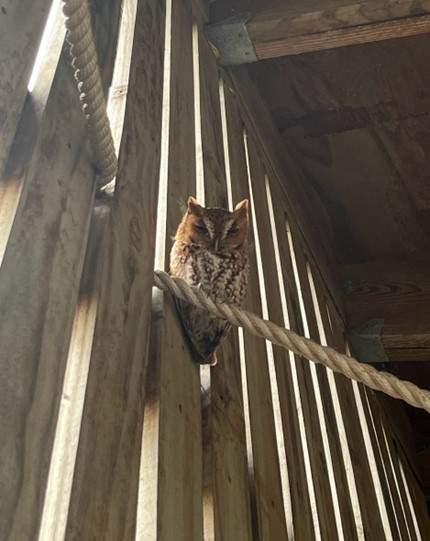
Eastern screech-owl (Megascops asio):
At a length of 8-18 inches with an 18-24 inch wingspan, the eastern screech-owl is the smallest species of owl in Florida and the eastern United States, and is a common species that can be found everywhere in multiple habitats including woodlands, swamps, forests, and even human dominated areas such as suburban gardens, orchards and parks. Besides nesting within the cavities of hardwood trees as tall as 30 feet, they’ve even been known to roost in nest boxes. Their diet is varied, but they prefer small animals ranging from insects and amphibians to rodents due to their size. With their big eyes and horn-shaped ear tufts, one might look at them as pint-sized versions of their much larger relative, the great horned owl. Despite the name, screech owls don’t “screech” but in actuality make simple hoots, more specifically either a quavering, toad-like trill or a more drawn out one. Eastern screech-owls also come in up to three color variations, or morphs. While gray and brown morphs are perhaps the most common versions, especially further north of the US, a red morph thrives in southern territories, especially in Florida. Like the American barn owl, the screech-owl has also gone through a scientific name change in recent years, having previously been associated within the genus and species Otus asio.
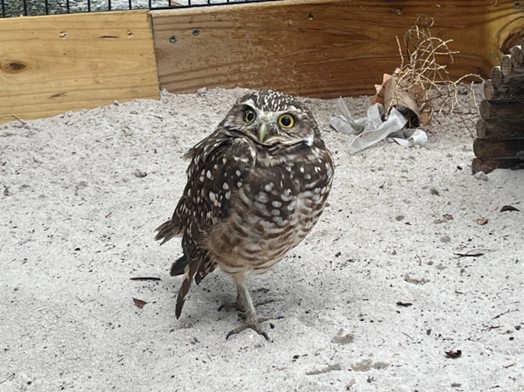
Burrowing owl (Athene cunicularia):
The second smallest owl species in Florida after the eastern screech-owl at 9-11 inches long and with a 20-24 inch wingspan, these little brown and white feathered, short-tailed owls are the only species in the state that make their nests in underground burrows leftover from other animals instead of trees, and have evolved longer legs to traverse terrain due to their more grounded lifestyle. While primarily nocturnal, burrowing owls are also crepuscular like the barred owl, and will perch themselves on rocks and mounds, and even human constructed fence posts and utility wires when hunting primarily for insects and smaller mammals to hunt. Like many owl species, burrowing owls are monogamous and colonies of mated pairs will stay together for life if at all possible, and come nesting season parents take turns feeding and looking after their offspring. Adult burrowing owls make a melancholic “coo-coo-roo” or “co-hoo” series of hoots, whilst chicks, should their nests be disturbed, will generate an alarm call that mimics the buzzing of rattlesnakes. Their choice of territory usually includes open grasslands and prairies, especially ones associated with prairie dogs further west from Florida (small rodents which are known for living in “towns” of multiple burrows). However like the eastern screech-owl they can also be seen near or within areas of human habitation including golf courses or near farmhouses and airports. While more burrowing owls exist in the western United States, the species is of special concern in Florida due to being threatened by automobile collisions, pest control poisons, and habitat destruction caused by their range being encroached upon by overdevelopment.
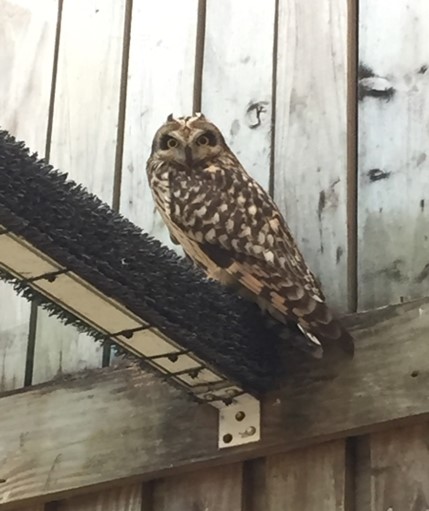
Short-eared owl (Asio flammeus):
A planet-wide distributed species of medium-sized owl (13-17 inches long with a 37-43 inch wingspan) that surprisingly seldom appears in Florida except during their migration season. The species is sandy to white-colored with a mosaic of darker brown streaks and blotches running down their bodies, as well as a black colored beak and yellow eyes surrounded by blackened highlights. Atop their skulls curving upwards and inwards over their foreheads stands a diminutive crown of two, horn-shaped tufts of feathers, although this is not always made visible by individuals. Outside of Florida in their normal ranges they prefer more open areas such as countrysides, tundras, savannas, pasturelands, and clearings at forest edges and even swamps. Similar to burrowing owls, short-eared owls hover over their prey of choice (usually voles and sometimes other small vertebrates), before swooping down to make their kills.
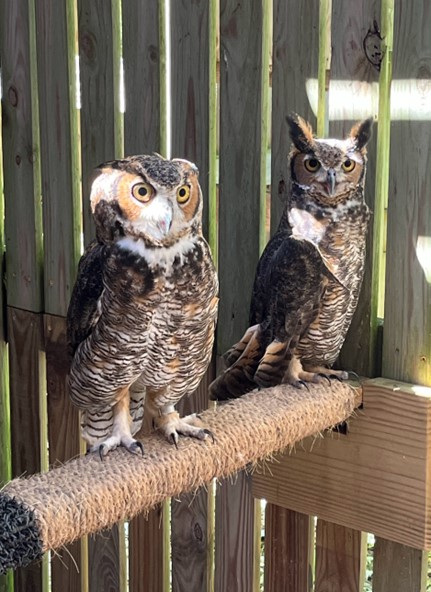
Great horned owl (Bubo virginianus):
Also known as the tiger owl due to their great size and more fearsome temperament, the great horned owl is the largest species of owl in Florida and the greater United States, at 18-25 inches long with a 36-60 inch wingspan, and covered in mottled brown, white and gray feathers. Adorning the tops of their skulls lies their trademark “horns'' which are of course elongated tufts of feathers (which they use both for camouflage and to communicate with other members of their species), while the fronts of their faces bear a black beak and a pair of massive, forward facing yellow eyes. To make up for the deceiving limitation of the lack of movable eyes, their necks have 14 vertebrae (humans by comparison have 7), allowing them to have greater flexibility for moving their skulls three-quarters of a circle. The key to their success as accomplished predators is due in part to their oversized feet and sharp, curved talons, which they use to grasp and restrain prey. Like ospreys, great horned owls are zygodactyls, meaning they can adjust their outermost toes to face backwards opposite their inner toes, and in the process have two toes both in front and behind their feet, allowing them to have a tighter grip on struggling prey. They have been recorded to have a grasping pressure of at least 500 pounds per square inch, making them the strongest raptors in the continent, stronger than even the bald eagle’s own 300 pound grasping force. As the most abundant species of owl in Florida and the US, even despite their size, great horned owls have adapted to living well across the country, preferably in swamps, woodlands, scrublands and rocky outcrops, as well as near areas of human habitation such as in parks. As for their vocals, great horned owls emit a series of bold, deep hoots (although the females emit a higher pitch than the males), running in a sound pattern described as “Whoo! Whoo-whoo-whoo! Whoo! Whoo!”
From Our Collection
By Alsop, Fred
598.2 Als
National Geographic Field Guide to Birds
598.2 Nat
Owls of the World: A Photographic Guide
By Mikkola, Heimo
598.97 Mik